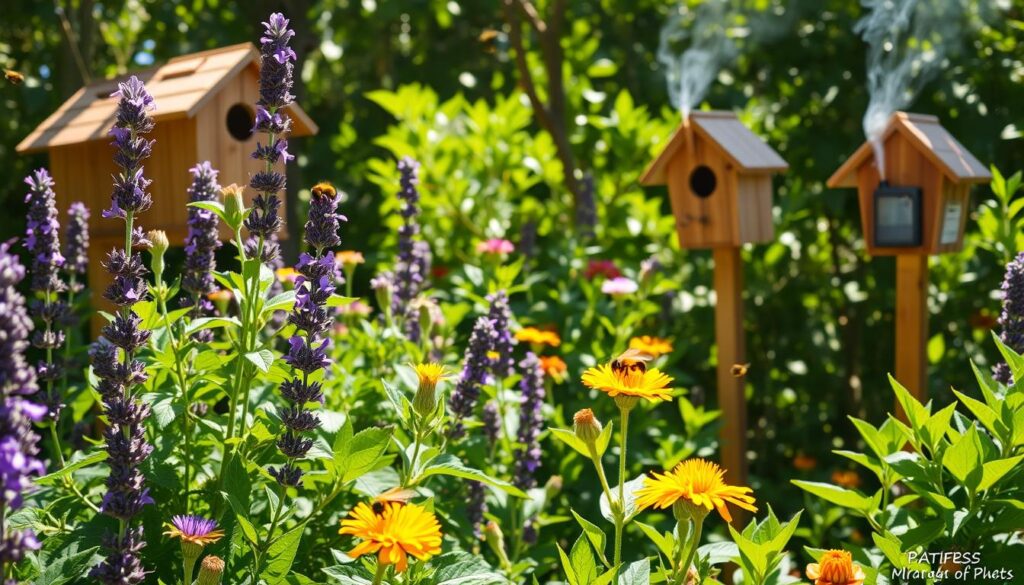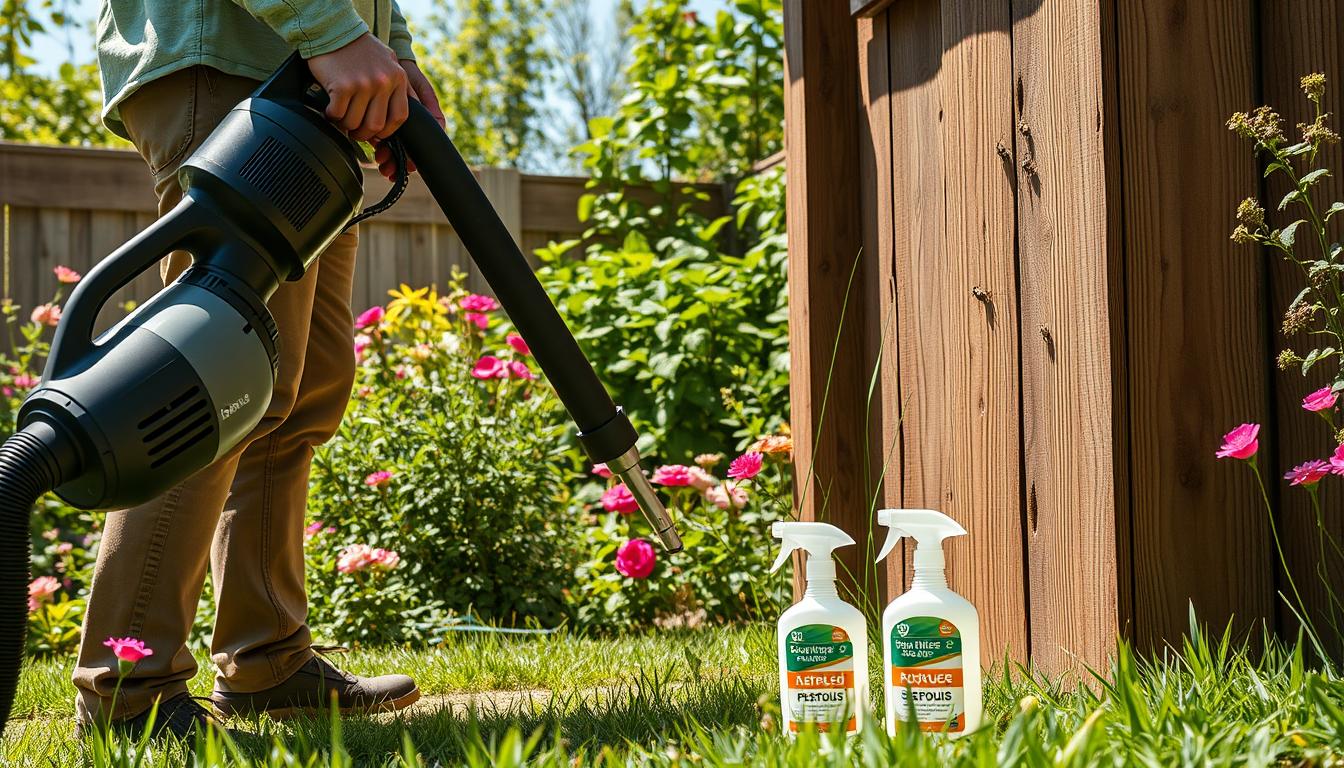Carpenter bees can cause a lot of damage to wooden structures in US backyards. They harm decks, fencing, and outdoor furniture. These bees from the Xylocopa genus are more than a nuisance. They threaten the integrity of your property.
Unlike other bees, carpenter bees don’t live in colonies. They dig tunnels in unprotected wood, posing long-term risks. Spotting carpenter bee activity early can prevent major damage and expensive fixes.
Key Takeaways
- Carpenter bees target untreated wooden structures in residential areas
- Early detection is critical for preventing extensive wood damage
- Multiple treatment approaches exist for carpenter bee removal
- Preventative measures can significantly reduce bee infestations
- Professional pest control might be necessary for severe cases
Understanding Carpenter Bees: Identification and Behavior
Carpenter bees are fascinating insects that play a big role in our ecosystem. They are often mistaken for bumblebees, but they have unique features. Knowing how to identify carpenter bees is key for managing pests and caring for the environment.
When identifying carpenter bees, look for their distinct physical traits. They are 1/2 to 1 inch long and have a shiny blue-black, green, or purple color. Unlike bumblebees, carpenter bees have smooth, shiny abdomens.
Physical Characteristics and Bee Species Comparison
- Size: 1/2 to 1 inch long
- Color: Metallic blue-black, green, or purple
- Abdomen: Smooth and shiny (unlike furry bumblebees)
- Gender differences: Males lack stingers, females can sting if provoked
Nesting Habits and Life Cycle
Carpenter bees prefer wooden structures for nesting. They are most active in spring and summer. During this time, they spend about six months looking for the perfect nesting spot.
| Nesting Characteristic | Details |
|---|---|
| Tunnel Size | Approximately 1/2 inch in diameter |
| Tunnel Length | Can excavate one inch per day |
| Offspring per Season | 4-5 offspring for a lone female |
| Preferred Wood | Untreated pine and cedar |
Common Areas of Infestation
Female carpenter bees are great at finding wood imperfections. They like untreated wooden structures, with up to 20% of infestations happening in unprotected wood. Common nesting sites include:
- Wooden decks
- Roof overhangs
- Wooden furniture
- Unpainted wood surfaces
“Understanding carpenter bee behavior is the first step in effective prevention and management.” – Entomology Research Institute
Signs of Carpenter Bee Damage in Your Property
Spotting carpenter bee damage early can prevent big problems with your wood. Carpenter bee holes are easy to spot. They are round, about 1/2 inch in diameter, and look like they were drilled with care.
It’s important to watch for signs of bee infestation. Here are some key things to look for:
- Circular holes with smooth edges in wooden surfaces
- Accumulation of sawdust-like debris beneath wooden structures
- Yellowish stains near entry points caused by bee waste
- Buzzing sounds emanating from within wooden materials
Wood damage from carpenter bees can be serious. Their tunnels can go up to 10 feet long. This weakens your property’s structure. Experts say you should act fast if you see many signs.
Most carpenter bee damage happens in untreated wood. This shows how important it is to take care of your wood.
| Damage Indicator | Severity Level |
|---|---|
| Single Round Hole | Low Risk |
| Multiple Holes | Moderate Risk |
| Extensive Tunneling | High Risk |
Spotting damage early and acting fast is key to avoiding big problems from carpenter bees.
Chemical Solutions for Carpenter Bee Control
Dealing with carpenter bee infestations needs careful use of pest control sprays and insecticides. Homeowners have many chemical options to manage and get rid of these wood-boring insects.
Experts say a detailed chemical control plan is best. It tackles both the current problem and future prevention.
Dust Insecticides: Precision Application
Dust insecticides are great for getting into carpenter bee nests. They are known for:
- Being very effective for treating nests
- Being applied directly into bee tunnels
- Working for a long time
Residual Spray Treatments
Residual insecticides create a barrier against carpenter bees. These sprays last 2-3 months if applied right.
| Insecticide Type | Application Frequency | Effectiveness Duration |
|---|---|---|
| Cyzmic CS | Twice during spring | 2-3 months |
| FenvaStar EcoCap | Every 3-4 weeks | 8-10 weeks |
Professional Treatment Options
For big infestations, getting help from professionals is key. They use special tools and treatments to get rid of carpenter bees.
*Professional help is needed when DIY methods don’t work or when damage is big.*
It’s important to spot carpenter bee problems early and treat them often. This helps prevent wood damage from these insects.
Natural and Non-Toxic Methods to Repel Carpenter Bees
You don’t need harsh chemicals to keep carpenter bees away. Natural bee repellents are safe for people and the planet. They can keep carpenter bees from harming your wood.
Essential oils are strong against carpenter bees. You can make simple sprays with common kitchen items.
- Citrus-based sprays (lemon, orange, grapefruit)
- Almond oil treatments
- Essential oil mixtures:
- Lavender oil
- Tea tree oil
- Citronella oil
Diatomaceous earth is another natural choice. It harms carpenter bees by damaging their skin. It works on both adults and young bees.
Sound vibrations can also keep carpenter bees away. This shows that there are many eco-friendly ways to control pests.
| Natural Repellent | Application Frequency | Effectiveness Rating |
|---|---|---|
| Citrus Spray | Every 3-4 days | High |
| Almond Oil | Weekly | Moderate |
| Essential Oil Mix | Every 5-7 days | High |
Using natural bee repellents regularly is important. These methods are part of a bigger plan to stop carpenter bee problems.
How to Get Rid of Carpenter Bees Using Prevention Techniques
To stop carpenter bees, you need to protect your wood and control them seasonally. These bees can harm your wooden buildings, making them weak if not treated.
Start by knowing how carpenter bees act and where they like to nest. They are most active in spring and summer. So, acting early is key to controlling them.
Wood Treatment Methods
Protecting your wood is key to keeping carpenter bees away. Here are some important steps:
- Paint or stain all exposed wooden surfaces
- Use hardwoods or pressure-treated lumber
- Apply protective wood sealants
- Regularly inspect wooden structures for potential entry points
Seasonal Prevention Strategies
Timing is everything to stop carpenter bees. Here’s how to control them seasonally:
| Season | Prevention Action | Effectiveness |
|---|---|---|
| Early Spring | Inspect and seal existing holes | High |
| Late Spring | Apply residual insecticides | Very High |
| Summer | Monitor and maintain wood treatments | Moderate |
| Fall | Repair damage and prepare for next season | High |
“Prevention is always more effective than treatment when it comes to carpenter bee control.” – Pest Management Expert
Pro tip: Carpenter bees don’t like painted wood or hardwoods. Protecting your wood well can save you money later.
Essential Protective Measures During Treatment
Dealing with carpenter bees needs careful attention to safety. The right protective gear can stop painful stings and make treatment safe. Female carpenter bees sting when they feel their nest is threatened, so it’s important to be careful.
Essential safety gear for bee sting prevention includes:
- Full-body protective bee suit
- Thick leather gloves
- Safety goggles or face shield
- Closed-toe boots with long pants
- Respiratory protection mask
When getting ready for carpenter bee treatment, follow these safety tips:
- Carefully read all chemical treatment instructions
- Ensure proper ventilation during treatment
- Keep children and pets away from treatment areas
- Have a first aid kit nearby
“Safety is not an accident, it’s a choice” – Unknown
Chemical treatments need extra care. Wear protective eyewear and gloves when handling insecticides. Treat during cooler parts of the day to reduce bee activity. Remember, male carpenter bees can’t sting but are aggressive, while females sting if threatened.
Experts say treat carpenter bee nests in late summer or early spring. Timing is key for safe and effective pest control. By following these safety steps, you can protect yourself and handle carpenter bee infestations well.
Using Carpenter Bee Traps Effectively
Carpenter bee traps are a smart way to deal with these pests. By knowing how they act and using the right traps, you can cut down their numbers near your home.
There are two main types of carpenter bee traps: store-bought and homemade. Each has its own benefits for fighting these wood-eating bugs.
DIY Trap Construction
Making your own bee traps is easy with a few tools and some basic carpentry skills. Here’s how to build them:
- Start with untreated wood blocks and drill holes in them
- Make the collector chambers at an angle under the holes
- Put clear containers on top
- Add BEE-Licious Bee Bait (just a small amount)
Proper Placement and Maintenance
Where you put your traps is very important. Each trap can cover about 15 feet, so picking the right spot is key.
- Place traps near where carpenter bees are seen
- Put them near wood that bees have damaged before
- Mount them at a 45-degree angle to attract more bees
- Keep them up until fall to catch all bee generations
“The key to successful carpenter bee control is consistent monitoring and strategic trap placement.” – Pest Control Expert
To keep your traps working well, check them often. Replace the bait when it’s gone and empty the containers to stop bees from getting out.
Wood Repair and Restoration After Infestation
Carpenter bee damage can weaken wooden surfaces. To fix this, we need to carefully check and repair the wood. This helps stop bees from coming back.
“Timely repair of carpenter bee damage is crucial to maintaining the longevity of wooden structures.” – Pest Control Experts
Homeowners should take a step-by-step approach to fix wood damaged by carpenter bees:
- Thoroughly inspect all damaged wood surfaces
- Clean and prepare the affected areas
- Select appropriate repair materials
- Implement protective treatments
How you fix carpenter bee damage depends on how bad it is. For small holes, you can use wood putty or special fillers. But, if the damage is really bad, you might need to replace the wood to keep it strong.
| Damage Level | Repair Technique | Estimated Cost |
|---|---|---|
| Minor Holes | Wood Putty/Caulk | $20-$50 |
| Moderate Damage | Partial Wood Replacement | $100-$300 |
| Extensive Damage | Complete Wood Replacement | $500-$1,500 |
After fixing bee damage, using wood sealants can keep bees away. These sealants make it hard for bees to make new holes.
Experts say it’s smart to check your wood often and take care of it. This helps avoid big problems from carpenter bees.
Eco-Friendly Deterrents and Repellents

Managing carpenter bees in a green way means using natural methods to keep your place safe. These methods are better for the environment and don’t harm you or your family.
Essential oils are great at keeping carpenter bees away. Certain oils, like tea tree oil and citronella, are very good at keeping these pests out.
- Tea tree oil
- Citronella
- Lavender
- Eucalyptus
- Peppermint
Diatomaceous earth is another natural way to control bees. It’s a fine powder that makes it hard for bees to nest and move around.
“Natural repellents provide a safe, effective approach to managing carpenter bee populations without compromising ecological balance.”
You can make your own bee repellent spray at home. Just boil citrus peels, strain the liquid, and put it in a spray bottle. Spray it on areas where bees might nest.
- Boiling citrus peels for 15-20 minutes
- Straining the liquid
- Transferring to a spray bottle
- Applying to potential nesting areas
Putting plants like mint and citronella around wooden areas can also help. These plants make a barrier that keeps carpenter bees away.
Using these green methods helps control carpenter bees without harming the environment. It also keeps other helpful insects safe.
When to Call Professional Pest Control
Carpenter bee infestations can quickly become a big problem. Many people try to fix it themselves, but some situations need a pro. This ensures the bees are removed safely and effectively.
Knowing when to call for help is key to keeping your home safe. Every year, many people end up in the hospital because of bee stings. This shows why trying to remove bees yourself can be risky.
Signs You Need Professional Intervention
- Large-scale infestations covering multiple wooden surfaces
- Nests located in hard-to-reach or high-traffic areas
- Structural damage exceeding small surface holes
- Previous DIY methods have proven ineffective
- Presence of secondary pest attractions
Cost Considerations for Exterminator Selection
The cost of pest control services depends on a few things. How big the problem is, how big your property is, and what treatment is needed all play a part. While DIY might seem cheaper, it can cause more harm than good.
“Professional pest control specialists possess the training and equipment required to safely handle both large infestations and nests located in sensitive areas.”
Choosing the Right Pest Control Service
When picking a bee removal service, look for these things:
- Verified pest control certifications
- Experience with carpenter bee treatments
- Comprehensive inspection and prevention strategies
- Transparent pricing and service guarantees
- Positive customer reviews and recommendations
Professional pest control can save you money in the long run. They prevent costly damage to your home. By choosing experts, you ensure your home is safe and well-protected from carpenter bees.
Long-Term Prevention Strategies
Creating a solid plan to stop carpenter bees is key to keeping your wood safe. It’s not just about treating the problem when it happens. You need a long-term plan to keep your wood safe.
Using good maintenance tips can really help. Regular checks are important to catch problems early. Look over your wood twice a year, especially on decks, eaves, and siding.
- Inspect wooden structures for signs of bee activity
- Seal existing holes before spring mating season
- Apply protective wood treatments annually
- Refinish exposed wooden surfaces
Managing your wood well is part of preventing carpenter bees. Use hardwoods like cedar or treated lumber when you can. Softwoods without finish are more at, so keep them covered.
| Prevention Strategy | Effectiveness Rating |
|---|---|
| Regular Wood Treatment | High |
| Sealing Existing Holes | Medium-High |
| Using Hardwoods | Medium |
“Prevention is always more cost-effective than extensive repairs”
Using natural things can help too. Try citrus scents or decoy wasp nests to keep carpenter bees away. Steel wool works well to block holes because bees don’t like metal.
Seasonal care is crucial for keeping carpenter bees away. Do your best work in spring and summer when bees are busy. With these steps, you can keep your wood safe and your property sound.
Safety Considerations and Best Practices
When dealing with carpenter bee infestations, safety is key. It’s important to protect yourself, your family, and the environment. This means planning and executing treatment strategies carefully.

Before starting any treatment, make sure you have the right protective gear. This ensures safe and controlled chemical handling. Proper preparation helps avoid bee stings and reduces risks.
- Wear protective clothing including long sleeves, pants, and closed-toe shoes
- Use safety goggles and chemical-resistant gloves
- Work in well-ventilated areas
- Keep children and pets away during treatment
To prevent bee stings, understand bee behavior and keep a safe distance. Carpenter bees can get aggressive if their nests are disturbed.
“Safety is not an accident, it’s a deliberate choice in pest management.” – Pest Control Professional
| Safety Measure | Recommended Action |
|---|---|
| Chemical Storage | Lock in secure, cool, dry location away from living spaces |
| Pesticide Disposal | Follow local hazardous waste guidelines |
| Emergency Preparedness | Keep first aid kit and contact information for poison control |
Pro tip: Always read and follow manufacturer instructions precisely when handling pest control chemicals.
Try to protect beneficial insects by focusing treatments on carpenter bee nests. Use responsible pest management to reduce environmental impact.
Conclusion
To keep your property safe from carpenter bees, you need a solid plan for pest control. Knowing how they behave and using the right prevention and treatment methods is key. By using a mix of strategies, you can greatly reduce infestations.
Early detection and action are crucial for effective pest control. Painting wood, sealing holes, and treating early in spring can help a lot. Traps and insecticides add extra protection, controlling bee numbers before they damage wood too much.
It’s important to manage carpenter bees without harming the environment. Instead of trying to get rid of them all, focus on prevention and control. Knowing their life cycle and nesting habits helps you manage them better.
Managing carpenter bees well means staying alert and adapting your approach. Regular checks, quick action, and understanding these bees are essential. This way, you protect your home and the environment.
Found this guide helpful? You’ll also like this one.

